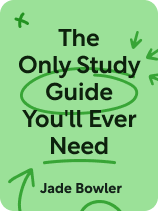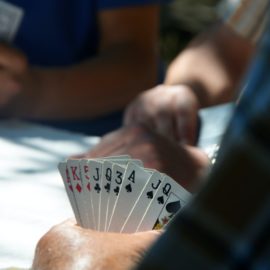

This article is an excerpt from the Shortform book guide to "The Only Study Guide You'll Ever Need" by Jade Bowler. Shortform has the world's best summaries and analyses of books you should be reading.
Like this article? Sign up for a free trial here.
What are the best study methods? How can you get the most out of your education?
In The Only Study Guide You’ll Ever Need, Jade Bowler discusses four main study methods that will help you maximize your learning in as little time as possible. These strategies include flashcards, memory testing, creating connections, and taking practice exams.
Here are the best study methods that your brain will approve of.
Method #1: Flashcards
One of the best study methods is the use of flashcards. While flashcards are a popular method for studying, Bowler explains that they’re ineffective if not created and used correctly. For flashcards to improve your understanding, they must incorporate your brain’s preferred learning methods.
First, flashcards should require deep engagement. There are a few ways you can do this. One of the easiest ways is to create cards with a question on one side and an answer on the other—before flipping the card over, you must answer the question yourself. This will make studying with flashcards harder than simply flipping through your cards and rereading information.
Another way to encourage deep engagement is to use as many symbols as possible on your cards in place of words and phrases. Using symbols rather than words requires you to recall more information than what’s explicitly written on the card. For example, imagine you want to remember that the Rashidun Caliphate was the first caliphate and lasted the shortest amount of time, the Umayyad was second and lasted longer than the Rashidun, and the Abbasid was the last and lasted the longest. You could write “Rashidun < Umayyad < Abbasid.”
Your flashcards should help you make connections with concepts you already know—Bowler explains that using images and symbols you’re familiar with is a great way to do this. For example, to remember the order of three of the major Medieval Islamic caliphates—the Rashidun, Umayyad, and Abbasid—you could draw a picture of a radish to remind you of “Rashidun,” a picture of your friend Maya to remind you of “Umayyad,” and the name of the band Abba to remind you of “Abbasid.”
Finally, the key to boosting learning with flashcards is to study them repeatedly over time. For example, if you have a quiz in one month’s time, rather than waiting until the week before the exam and studying for 30 minutes every day, make your flashcards and start studying as soon as you find out about the exam.
Method #2: Memory Testing
Bowler explains that testing your memory and understanding is extremely helpful when studying because recalling the information requires deep engagement. Testing also allows you to gauge what you know, what you don’t know, and what you need to work on. She recommends two ways of testing your memory.
The first method involves trying to condense a concept into its most crucial components from memory alone. Then, compare what you’ve written to your full notes to see how well you understand the concept and identify anything that you forgot or misrepresented. This facilitates engagement and application. (Bowler calls this technique “summarization from memory.”)
(Shortform note: This method for memory testing is likely effective because it mimics and possibly expedites the second stage of your brain’s learning process. In Make It Stick, the authors explain that during the first stage of learning, your brain encodes new information in your short-term memory. During the second stage, your brain transfers knowledge into long-term memory through consolidation: It revisits your encoded memories and fills in logic gaps, draws connections, and identifies crucial components. Bowler’s recommendation to condense concepts into their most crucial components, review what you missed, and fill gaps in your memory helps and likely expedites consolidation by forcing you to actively go through it.)
Bowler’s second testing method involves writing down every single thing you can remember about a concept. To do this, start by writing down a few words that will remind you of the concept. Then, use those prompts to jog your memory and write down everything you can remember about the concept. Once you’re done, compare your exercise to your notes and identify what you left out—these are likely the areas you need to work on. (Bowler calls this method “blurting.”)
For example, if you have a Spanish exam on words used in the kitchen, you might write a few prompts to help jog your memory about the themes of the vocabulary: “los cubiertos (eating utensils)” and “comida (food).” Then, you can list out every vocabulary word you remember based on these themes: “tenedor (fork),” “cuchillo (knife),” “manzana (apple),” “naranja (orange),” and so on. Compare your list to your notes to ensure each term is spelled and translated correctly, and make note of anything you forgot.
(Shortform note: Blurting has become such a popular method of studying that teachers have created blurting worksheets and templates. These papers are specifically designed to help students test their knowledge and then actively reflect on what they remember and what they need to spend more time revising.)
Method #3: Create Connections
Bowler recommends creating connections between new concepts that you’re learning and your prior knowledge through storytelling. She presents three different ways you can do so:
First, you can sort pieces of information into groups and connect each group in a logical narrative format. Bowler recommends this method because it connects the information you’re learning in a way that makes sense to you, making it easier to recall. (Bowler calls this method “chunking, chaining, and telling a story.”)
For example, if you’re studying for your Spanish exam, you can sort the vocabulary words for food into one group, cooking utensils into another, and table utensils into another. Then, tell a story about making dinner and use each group as a part of the process: First, you gather the food; then, you gather the cooking utensils; and once the meal is done, you eat with the table utensils.
Second, you can connect elements of a concept you’re learning to elements of a routine you perform regularly—this is especially helpful for processes you have to memorize or elements that have a particular order. (Bowler calls this method “Sherlock’s mind palace.”)
For example, you can connect each color of the rainbow to an action or object of your morning routine: First, you wake up underneath your red duvet. Next, you put on your orange slippers. Then, you go to the bathroom which has yellow walls. In the bathroom, you pick up the green toothpaste tube and use your blue toothbrush. Finally, you put on your indigo robe and say good morning to your mother, who is named Violet.
Third, you can connect elements of a concept to parts of a physical object—when you look at the object, it will help you remember the elements of the concept. For example, connect the three main stages of the hydrologic cycle to your water bottle: First is evaporation—you can connect this stage to the top part of your water bottle that’s foggy because of evaporation. Next is condensation—you can connect this to the water droplets inside your bottle and imagine that they’re the product of condensation, like raindrops. Finally, connect precipitation to the water sitting at the bottom of your bottle—imagine this is the rainwater that has fallen and collected.
Method #4: Practice Taking the Exam
Finally, Bowler recommends completing past papers—real exam papers from previous years—or taking a practice exam on the subject you’re studying for. These methods provide the experience of answering the types of questions on the real exam.
Past papers are often available online or can be provided by your teacher or the exam board. If you don’t have access to past papers, create your own practice exam. To do this, look at past essay prompts, homework assignments, textbook review sections, and any revision guidelines the teacher has provided, and pick a prompt that might mimic a real exam. For example, if your exam will ask you to write a two-page essay about Macbeth in 60 minutes, choose a past essay prompt similar to a real exam question and practice writing the timed essay at home. If your exam is on the history of the Islamic empire, create an exam out of the textbook review questions for the chapters you’ll be quizzed on.
(Shortform note: Using past papers and practice exams to prepare for real exams is one of the most popular and highly recommended study strategies out there. Numerous sites now offer detailed past papers, model answers, and revision notes. Using these pre-collected resources will save time you would have otherwise spent combing through the internet or old notes for study inspiration. Sites like Save My Exams are tailored to help you ace the exact exam and subject you’re preparing for. American students preparing for nation-specific exams like the SAT or ACT can visit resources like Khan Academy for study guides and practice exams. Other nation-specific exam prep tools can also be found with a quick Google search.)

———End of Preview———
Like what you just read? Read the rest of the world's best book summary and analysis of Jade Bowler's "The Only Study Guide You'll Ever Need" at Shortform.
Here's what you'll find in our full The Only Study Guide You'll Ever Need summary:
- Why school doesn't have to be chronically overwhelming
- How students can manage their mindset, study habits, and time
- Science-backed time management and study techniques to help you ace your exams






